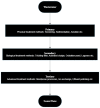Microplastic Removal in Wastewater Treatment Plants (WWTPs) by Natural Coagulation: A Literature Review
- PMID: 38250968
- PMCID: PMC10819662
- DOI: 10.3390/toxics12010012
Microplastic Removal in Wastewater Treatment Plants (WWTPs) by Natural Coagulation: A Literature Review
Abstract
Urban industrialization has caused a ubiquity of microplastics in the environment. A large percentage of plastic waste originated from Southeast Asian countries. Microplastics arising from the primary sources of personal care items and industrial uses and the fragmentation of larger plastics have recently garnered attention due to their ubiquity. Due to the rising level of plastic waste in the environment, the bioaccumulation and biomagnification of plastics threaten aquatic and human life. Wastewater treatment plant (WWTP) effluents are one of the major sources of these plastic fragments. WWTPs in Southeast Asia contribute largely to microplastic pollution in the marine environment, and thus, further technological improvements are required to ensure the complete and efficient removal of microplastics. Coagulation is a significant process in removing microplastics, and natural coagulants are far superior to their chemical equivalents due to their non-toxicity and cost-effectiveness. A focused literature search was conducted on journal repository platforms, mainly ScienceDirect and Elsevier, and on scientific databases such as Google Scholar using the keywords Wastewater Treatment Plant, Coagulation, Microplastics, Marine Environment and Southeast Asia. The contents and results of numerous papers and research articles were reviewed, and the relevant papers were selected. The relevant findings and research data are summarized in this paper. The paper reviews (1) natural coagulants for microplastic removal and their effectiveness in removing microplastics and (2) the potential use of natural coagulants in Southeast Asian wastewater treatment plants as the abundance of natural materials readily available in the region makes it a feasible option for microplastic removal.
Keywords: Southeast Asia; coagulation; marine environment; microplastics; wastewater treatment plant.
Conflict of interest statement
The authors declare no conflicts of interest.
Figures
Similar articles
-
Efficiency of Wastewater Treatment Plants (WWTPs) for Microplastic Removal: A Systematic Review.Int J Environ Res Public Health. 2020 Oct 30;17(21):8014. doi: 10.3390/ijerph17218014. Int J Environ Res Public Health. 2020. PMID: 33143273 Free PMC article.
-
Nationwide evaluation of microplastic properties in municipal wastewater treatment plants in South Korea.Environ Pollut. 2024 Oct 1;358:124433. doi: 10.1016/j.envpol.2024.124433. Epub 2024 Jun 24. Environ Pollut. 2024. PMID: 38925216
-
Microplastic removal and management strategies for wastewater treatment plants.Chemosphere. 2024 Jan;347:140648. doi: 10.1016/j.chemosphere.2023.140648. Epub 2023 Nov 10. Chemosphere. 2024. PMID: 37952815 Review.
-
Occurrence, characteristics, and removal of microplastics in wastewater treatment plants located on the Moroccan Atlantic: The case of Agadir metropolis.Sci Total Environ. 2023 Mar 1;862:160815. doi: 10.1016/j.scitotenv.2022.160815. Epub 2022 Dec 9. Sci Total Environ. 2023. PMID: 36502989
-
A holistic approach on the impact of microplastic discharge from WWTPs to the neighboring environment in Southeast Spain.Water Res. 2023 Oct 1;244:120516. doi: 10.1016/j.watres.2023.120516. Epub 2023 Aug 22. Water Res. 2023. PMID: 37651865
Cited by
-
Microplastic contamination of bryophytes: A review on mechanisms and impacts.Heliyon. 2024 Aug 14;10(16):e36360. doi: 10.1016/j.heliyon.2024.e36360. eCollection 2024 Aug 30. Heliyon. 2024. PMID: 39253117 Free PMC article. Review.
-
Microbial Succession on Microplastics in Wastewater Treatment Plants: Exploring the Complexities of Microplastic-Microbiome Interactions.Microb Ecol. 2024 Aug 12;87(1):105. doi: 10.1007/s00248-024-02422-y. Microb Ecol. 2024. PMID: 39133233 Free PMC article. Review.
-
Sustainable coagulative removal of microplastic from aquatic systems: recent progress and outlook.RSC Adv. 2025 Jul 16;15(31):25256-25273. doi: 10.1039/d5ra04074d. eCollection 2025 Jul 15. RSC Adv. 2025. PMID: 40673253 Free PMC article. Review.
-
Mitigating Dietary Microplastic Accumulation and Oxidative Stress Response in European Seabass (Dicentrarchus labrax) Juveniles Using a Natural Microencapsulated Antioxidant.Antioxidants (Basel). 2024 Jul 5;13(7):812. doi: 10.3390/antiox13070812. Antioxidants (Basel). 2024. PMID: 39061881 Free PMC article.
-
Pollution of Beach Sands of the Ob River (Western Siberia) with Microplastics and Persistent Organic Pollutants.J Xenobiot. 2024 Jul 25;14(3):989-1002. doi: 10.3390/jox14030055. J Xenobiot. 2024. PMID: 39189170 Free PMC article.
References
-
- Hale R.C., Seeley M.E., La Guardia M.J., Mai L., Zeng E.Y. A Global Perspective on Microplastics. J. Geophys. Res. Oceans. 2020;125:e2018JC014719. doi: 10.1029/2018JC014719. - DOI
-
- OECD . Plastic Pollution is Growing Relentlessly as Waste Management and Recycling Fall Short, Says OECD. OECD; Paris, France: 2022.
Publication types
Grants and funding
LinkOut - more resources
Full Text Sources





